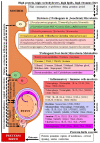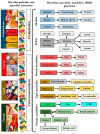Molecular Mechanism of Microbiota Metabolites in Preterm Birth: Pathological and Therapeutic Insights
- PMID: 34360908
- PMCID: PMC8347546
- DOI: 10.3390/ijms22158145
Molecular Mechanism of Microbiota Metabolites in Preterm Birth: Pathological and Therapeutic Insights
Abstract
Preterm birth (PTB) refers to the birth of infants before 37 weeks of gestation and is a challenging issue worldwide. Evidence reveals that PTB is a multifactorial dysregulation mediated by a complex molecular mechanism. Thus, a better understanding of the complex molecular mechanisms underlying PTB is a prerequisite to explore effective therapeutic approaches. During early pregnancy, various physiological and metabolic changes occur as a result of endocrine and immune metabolism. The microbiota controls the physiological and metabolic mechanism of the host homeostasis, and dysbiosis of maternal microbial homeostasis dysregulates the mechanistic of fetal developmental processes and directly affects the birth outcome. Accumulating evidence indicates that metabolic dysregulation in the maternal or fetal membranes stimulates the inflammatory cytokines, which may positively progress the PTB. Although labour is regarded as an inflammatory process, it is still unclear how microbial dysbiosis could regulate the molecular mechanism of PTB. In this review based on recent research, we focused on both the pathological and therapeutic contribution of microbiota-generated metabolites to PTB and the possible molecular mechanisms.
Keywords: metabolites; microbiota; molecular mechanism; postbiotics; preterm; probiotics.
Conflict of interest statement
The authors declare no conflict of interest.
Figures




Similar articles
-
Microbiome-producing SCFAs are associated with preterm birth via trophoblast function modulation.mBio. 2024 Dec 11;15(12):e0270224. doi: 10.1128/mbio.02702-24. Epub 2024 Nov 11. mBio. 2024. PMID: 39526775 Free PMC article.
-
Butyrate-producing bacteria in pregnancy maintenance: mitigating dysbiosis-induced preterm birth.J Transl Med. 2025 May 12;23(1):533. doi: 10.1186/s12967-025-06534-y. J Transl Med. 2025. PMID: 40355924 Free PMC article.
-
Shotgun sequencing of the vaginal microbiome reveals both a species and functional potential signature of preterm birth.NPJ Biofilms Microbiomes. 2020 Nov 12;6(1):50. doi: 10.1038/s41522-020-00162-8. NPJ Biofilms Microbiomes. 2020. PMID: 33184260 Free PMC article.
-
Dysbiosis and Prematurity: Is There a Role for Probiotics?Nutrients. 2019 Jun 5;11(6):1273. doi: 10.3390/nu11061273. Nutrients. 2019. PMID: 31195600 Free PMC article. Review.
-
The Microbiome and Complement Activation: A Mechanistic Model for Preterm Birth.Biol Res Nurs. 2017 May;19(3):295-307. doi: 10.1177/1099800416687648. Epub 2017 Jan 11. Biol Res Nurs. 2017. PMID: 28073296 Free PMC article. Review.
Cited by
-
Microbiome Changes in Pregnancy Disorders.Antioxidants (Basel). 2023 Feb 12;12(2):463. doi: 10.3390/antiox12020463. Antioxidants (Basel). 2023. PMID: 36830021 Free PMC article. Review.
-
Intestinal Microbiota in Early Life: Latest Findings Regarding the Role of Probiotics as a Treatment Approach for Dysbiosis.Nutrients. 2025 Jun 21;17(13):2071. doi: 10.3390/nu17132071. Nutrients. 2025. PMID: 40647176 Free PMC article. Review.
-
Metabonomics profile analysis in inflammation-induced preterm birth and the potential role of metabolites in regulating premature cervical ripening.Reprod Biol Endocrinol. 2022 Sep 6;20(1):135. doi: 10.1186/s12958-022-01008-y. Reprod Biol Endocrinol. 2022. PMID: 36068532 Free PMC article.
-
Role of the gut microbiota in hematologic cancer.Front Microbiol. 2023 Aug 25;14:1185787. doi: 10.3389/fmicb.2023.1185787. eCollection 2023. Front Microbiol. 2023. PMID: 37692399 Free PMC article. Review.
-
Effects of emergency/nonemergency cervical cerclage on the vaginal microbiome of pregnant women with cervical incompetence.Front Cell Infect Microbiol. 2023 Mar 9;13:1072960. doi: 10.3389/fcimb.2023.1072960. eCollection 2023. Front Cell Infect Microbiol. 2023. PMID: 36968117 Free PMC article. Clinical Trial.
References
Publication types
MeSH terms
Grants and funding
LinkOut - more resources
Full Text Sources
Molecular Biology Databases

